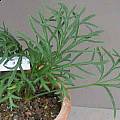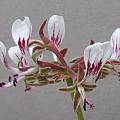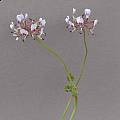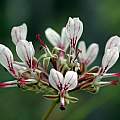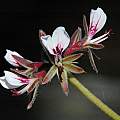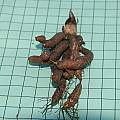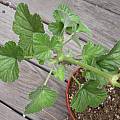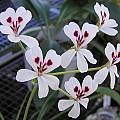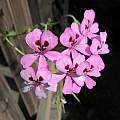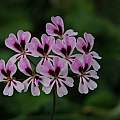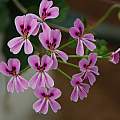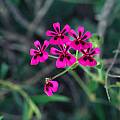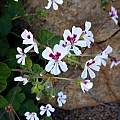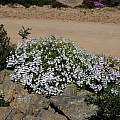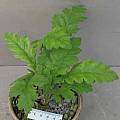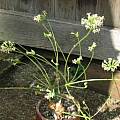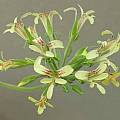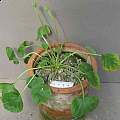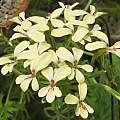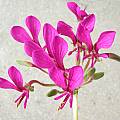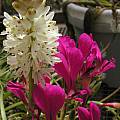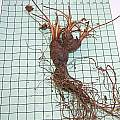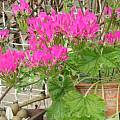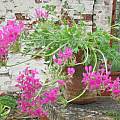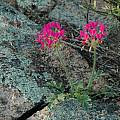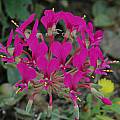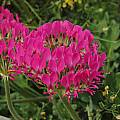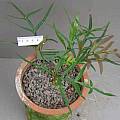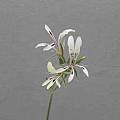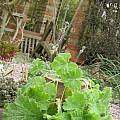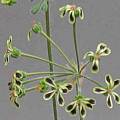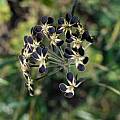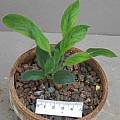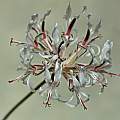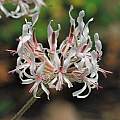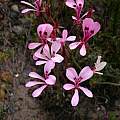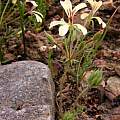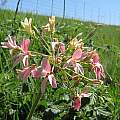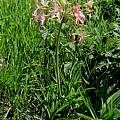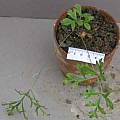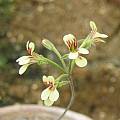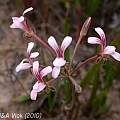Pelargonium species d-l are listed on this page.
Pelargonium a-c - Pelargonium m-p - Pelargonium q-s - Pelargonium t-z - Pelargonium index
Pelargonium dipetalum L'Hér. is a tuberous plant from the Southern Cape of South Africa, from Betty’s Bay to the Keurboomsrivier. It is found on foothills or flats on limestone rides or sandstone slopes or on shale in coastal fynbos. As its name indicates, this is a two petalled plant, which can be coloured white or pink, with dark red feathering. It flowers from February to April. (Section Hoarea, Auritum Group). Photos from David Victor and Mary Sue Ittner. The last shows a tuber on a 1 cm grid.
Pelargonium echinatum Curtis is a branched shrub with a tuber. It is found on stony slopes in Namaqualand southwards to Clanwilliam in the Western Cape of South Africa. Its branched, fleshy stems are armed with persistent, recurved spine-like stipules which give it its name. Leaves are scalloped and heart-shaped. Flowers are white, pink to purple, with darker markings. The last two photos were taken in Namaqualand at a display area where a number of different plants including succulents were being grown. Photos by Mary Sue Ittner.
The first photo by Mary Sue Ittner shows one peeking through the shrubs in the Gifberg, August 2001. The next two photos were taken by Cameron McMaster in Namaqualand.
Pelargonium fasciculaceum E.M. Marais is a tuberous plant from the Western Cape area of South Africa, where it grows on the Olifants River in sandy places and in mountain fynbos on the Nardous and Bokkeveld plateau. Flowers are pale yellow or cream and the upper two have v-shaped red markings. It flowers from December to January. The name refers to the large number of flowers forming a cluster as they diverge from a common centre. (Section Hoarea, Aciculatum Group). Photos David Victor.
Pelargonium grenvilleae Harv. is a tuberous plant from Namaqualand in South Africa, where it grows from Steinkopf to Kamiesberg, in sand or loam in very dry areas. Flowers are cream coloured with small red marks at the base of the top two. It flowers from September to October. It is named after its introducer to England, Lord Grenville. (Section Hoarea, Incrassatum Group). Photos David Victor.
Pelargonium incrassatum Sims is native to the Northwestern Cape where it is found in elevated mountainous areas and their foothills, sometimes in areas with very little rainfall and sometimes in areas with more. It belongs to Section Hoarea, Incrassatum Group. The species epithet is derived from the thickened, succulent leaves. It should be kept dry during dormancy. I have found it difficult to grow in my wet winters and have it sheltered from the rain in a structure covered on top but with open sides. It probably needs more light. In cultivation, it flowers in late summer-early fall (August to October). Photos 1-3 were taken by Mary Sue Ittner of plants grown from seed. Photo 2 shows it blooming with Lachenalia contaminata and photo 3 shows the large tuber in dormancy on a 1 cm grid. Photos 4-5 were taken by David Victor.
Photos taken in Namaqualand September 2006 by Bob Rutemoeller.
Pelargonium leptum Sims is a tuberous plant from the Southwest Cape of South Africa, from the vicinity of Kuilsrivier and Durbanville in the South and between Paarl and Malmesbury in the North. It grows in sandy soil in mountain fynbos. Flowers may be white, cream, pale yellow or pale pink. The upper two petals have wine red feathering and lower petals wine-red stripes in the centre. Flowering is from December to February. The name, meaning slender, derives from the long thin petals. (Section Hoarea, Attenuatum Group). Photos David Victor.
Pelargonium lobatum (Burm. f.) L'Hér. is a tuberous plant from the Southwest Cape of South Africa, from Picketberg to the District of George, growing along sandy coastal flats to 150 kms inland in fynbos. This is a woody, tuberous plant, with enormous leaves (up to 30 cms across) almost entirely covered with a soft, dense velvety hair. It is sweetly scented at night (for pollination by moth?). It flowers from September to November. The name refers to its leaf shape. (Section Polyactium). The first two photos by David Victor. The third was taken in the West Coast area of the Cape Province in September 2001 by Mary Sue Ittner.
Pelargonium longifolium Jacq. is a tuberous plant from the Southwest Cape of South Africa, from Citrusdal to the Cape Peninsula to Bredasdorp where it grows in sandy fynbos. A variable plant up to 25 cm tall, leaves can be undivided or finely dissected, smooth or hairy. Flowers can be white, cream, yellow or pink, with conspicuous wine-red blotches on the upper petals. It flowers from late spring to early summer (October to December) after the leaves have dried. The name refers to the length of its leaves. (Section Hoarea, Attenuatum Group). The first photo of leaves from David Victor and the next two from Mary Sue Ittner of flowers from plants grown from Silverhill seeds. The last two photos from the book Plants of the Klein Karoo courtesy of Jan and Anne Lise Schutte-Vlok.
Pelargonium luridum (Andrews) Sweet is a tuberous plant that grows in grassland from the Eastern Cape to Tanzania. Leaves are shallowly to deeply lobed or threadlike and the unblotched flowers are pink, cream or white. It is an edible species, also used in traditional medicine. Photos from Cameron McMaster were taken in the Eastern Cape.
Pelargonium luteolum N.E. Br. is a tuberous plant growing to 20 cm from Southwestern South Africa, from Garies in Namaqualand, along the coast to Worcester and along the south coast to Kleinpoort. It grows on sandstone, shale or quartzite in various types of vegetation. Leaves are hairy, finely dissected into lobes, and are usually dry when plants are in flower. The flowers may be cream, almost white or yellow, or pink with wine red markings along the main veins. It flowers from summer to autumn (November to March). The name refers to the yellow colour of its flowers. (Section Hoarea, Luteolum Group). The first two photos from David Victor. The last photo from the book Plants of the Klein Karoo courtesy of Jan and Anne Lise Schutte-Vlok.
Pelargonium a-c - Pelargonium m-p - Pelargonium q-s - Pelargonium t-z - Pelargonium index - Pelargonium index
